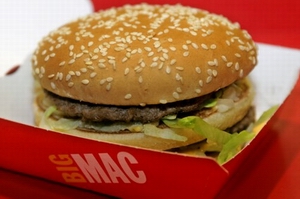 ny industries, especially service industries like retail and restaurants, there’s a widespread belief that companies can’t survive unless they pay as little as possible. Labor is an input. A company that pays more than it has to for any input—raw materials, rent, energy—isn’t doing the best it can.
ny industries, especially service industries like retail and restaurants, there’s a widespread belief that companies can’t survive unless they pay as little as possible. Labor is an input. A company that pays more than it has to for any input—raw materials, rent, energy—isn’t doing the best it can.That’s the mentality at Walmart, and at McDonald’s, where workers making as little as $7.25 per hour walked off the job this week. And it’s the mentality behind the comical financial planning tool McDonald’s and Visa recently put out suggesting that full-time workers’ monthly budgets should include a second full-time job and no line item for food or heat.
Business owners act as if low wages are thrust upon them by circumstances they are powerless to resist. But that’s emphatically not true. Pay is a conscious decision. (In the case of McDonald’s, it should be noted that pay is set by many local franchisees.) “Low wages are not a necessity, they’re a choice,” said Zeynep Ton, adjunct associate professor at MIT’s Sloan School of Business, and author of the forthcoming book The Good Jobs Strategy. Ton examined companies in the retail industry—“the epitome of bad jobs in the U.S.”—and focused on retailers who paid better wages and benefits and had a philosophy that “people are assets to be maximized.” At high-performing companies in low-wage industries like Costco, she found, higher wages often go hand-in-hand with operational excellence.
And there are examples in the casual-dining and fast-food sectors of companies that pay wages that, while not good by anyone’s definition, are certainly better. The best example may be In-N-Out, where workers start at $10.50 an hour. In-N-Out has a strange, somewhat secretive corporate culture. But the California-based chain has stealthily become a huge company, with 283 outlets. “We start all our new Associates at a minimum of $10.50 an hour for one simple reason,” the company notes on its homepage. “You are important to us!” Among the benefits it offers to full-time workers are “a package of medical, dental, and vision benefits,” a retirement plan with “ a Defined Contribution Profit Sharing Plan and 401(k) Plan,” free meals on work days, and paid vacations.
Or take Dicks Drive-in, a six-store chain in the Seattle area, whose menu of benefits resembles that of a technology company. Wages start at $10 per hour, but the benefits include “100% employer-paid health insurance and employer-subsidized dental insurance to every employee who works at least 24 hours per week,” educational scholarships, child-care assistance, and paid community service. It’s a way of—duh!—retaining people. “Almost one-third of all Dick's employees have worked for the company for 2 years or more,” the company notes.
Moo Cluck Moo, a new burger joint in Detroit, where Henry Ford shocked the business world nearly a century ago by doubling factory wages to $5 a day, pays $12 an hour. “We did this because, in our mind, it was the right thing to do,” cofounder Harry Moorhouse told The Detroit News. “This is too hard a job to pay minimum wage. So far, we haven’t lost any employees and we sleep well at night knowing that.”
The Restaurant Opportunities Center, a union-affiliated group, issued a report last year on companies that take the “high road,” flagging chains that pay better than peers and offer career-advancement opportunities, like El Fuego in Philadelphia and Zingerman’s in Ann Arbor.
Now, it’s not much easier to live on $10 an hour than it is on $7.25 an hour. But more is better, especially when those wages are paired with benefits. And as these companies grow and prosper, it sends an important message: there’s more to life than low wages. There are other ways to boost profits, even in low-wage businesses. Pay more upfront and you’re likely to see better customer service, and you may save more in the long run on training or absenteeism.
In this day and age, higher pay can also be a brand differentiator. Most consumers don’t care about low wages, but some people do. And as time goes on, more people will. Low wages are a form of negative advertising and public relations, like yesterday’s job actions. Higher wages can be a form of positive advertising and good public relations—like this article.





